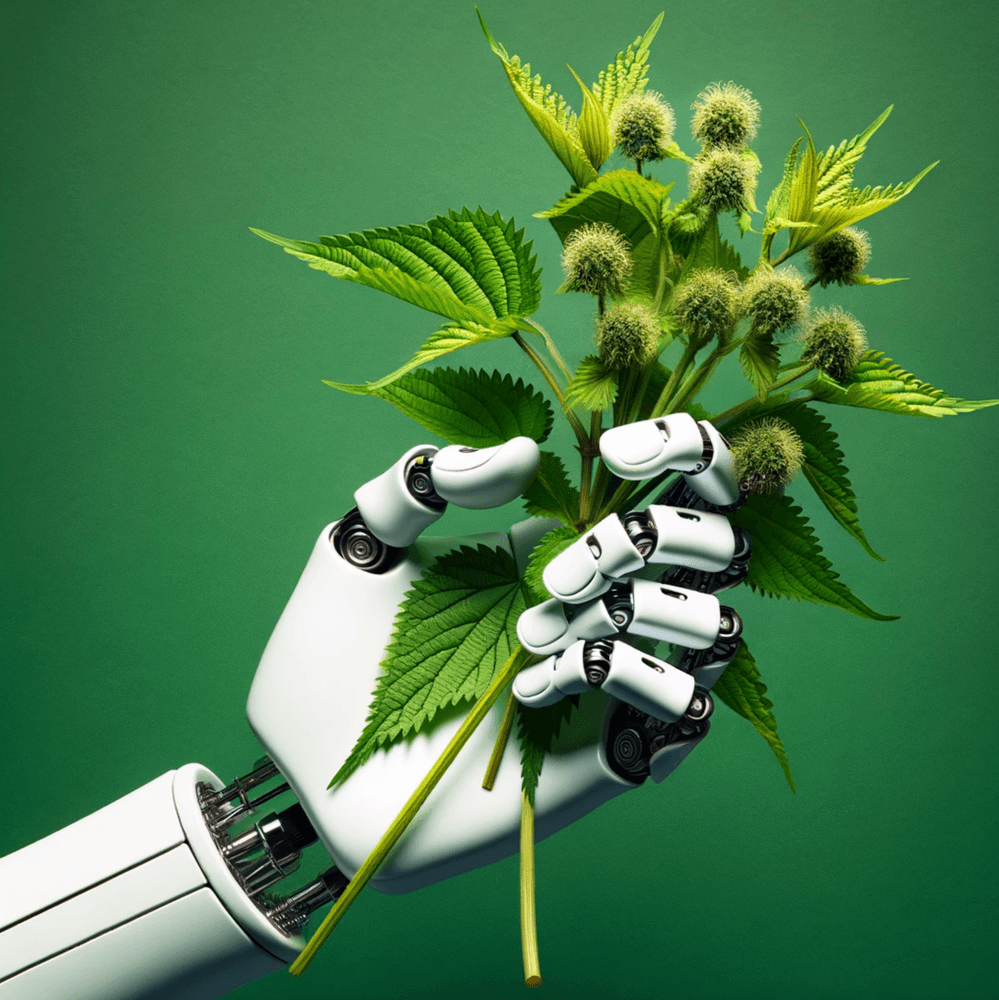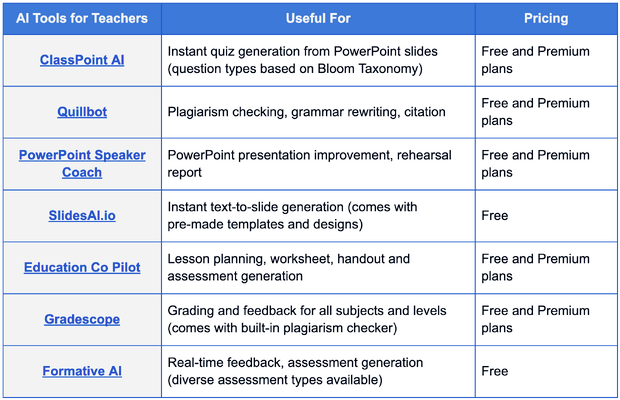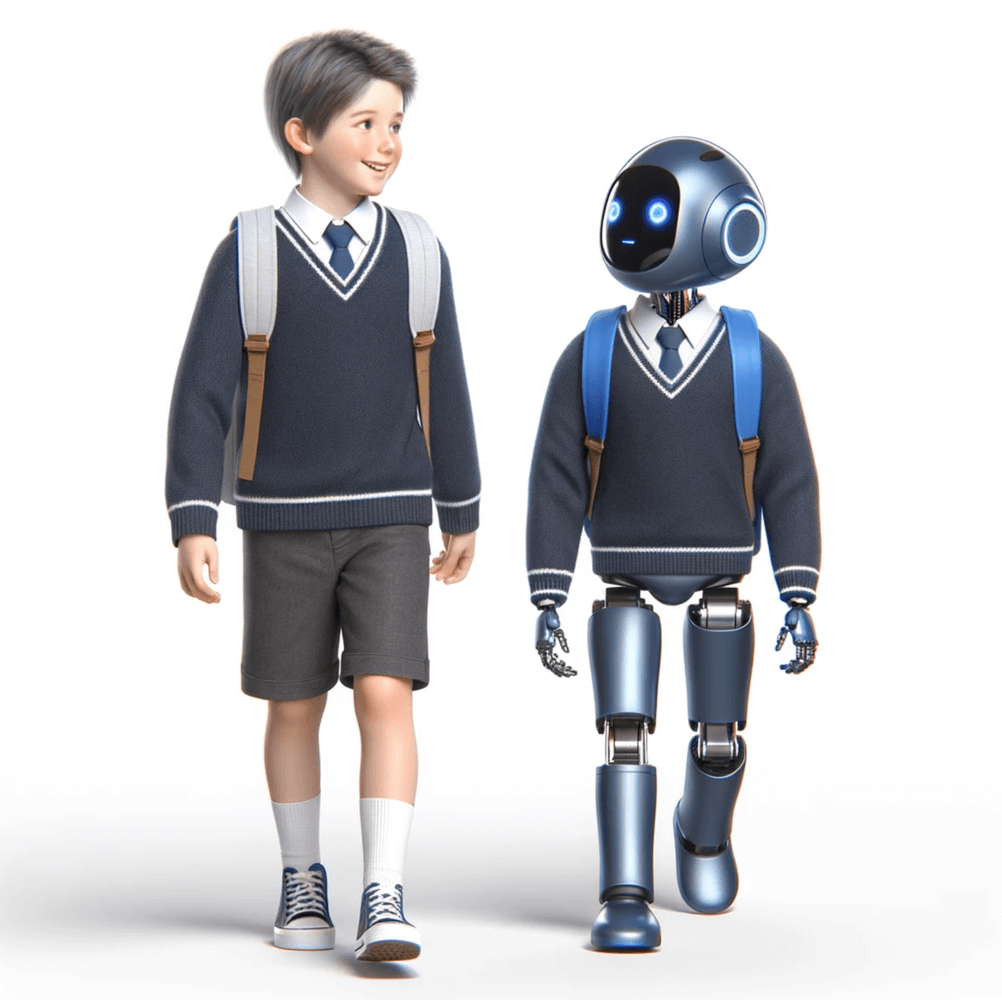In my 6th article I am addressing the contrived dilemma of trying to apply controlling measures to AI as pupils learn, so as not to ‘ruin’ their education and the ability to think for themselves, while preparing them to land jobs in an increasingly AI augmented workplace.
The paradox of AI in education is that whilst most of us accept that it will continue to automate out the repetitive, process heavy and analytical aspects of work for most careers, we must maintain a level of true understanding of what we are learning. AI is already infamous for its ability to plagiarise with consummate ease and ‘do our homework’ for us, which has created a deep sense of distrust within academia and pupils’ parents alike.
Education is struggling to address AI. The innate ability for AI to ‘create’ for you by proxy, and wax lyrical about wax, lyrics or anything you choose while you gaze out of the window, across the campus fields is sending shivers down the collective academic spine.
Thankfully, my job is not to create prose. But the purpose of the paragraph I wrote above, where I used a little imagination, is to illustrate that AI would not have come up with that choice of wording. Without an iterative, lengthy, detailed prompt to explain the nuances of the response I desire, AI is generally quite poor at being that creative or that authentic. This is one of the reasons I am not worried about the imminent collapse of creative application.
While AI in education is, in the most negative view, focussed on ‘cheating’ coupled with the fear of the loss of creative skills and the cognitive thought process, there’s way more than that to consider. In this article I will highlight some of the key aspects that could or should be impacted by AI and some of the areas that are best left alone.
Abandon hope or knuckle down?
Do we fling our arms up and admit defeat? Should we ban powerful Large Language Model (LLM) ‘learning tools’ like ChatGPT in a draconian attempt to save centuries of educational tradition from the clutches of Musk and Altman et al? Or, do we carefully adapt and exploit this exciting new paradigm and accept the challenges that come with it? For this to happen, we’d likely need to task the best technical minds to overcome educational quandaries that are crippling schools and preventing authorities and many developing nations from funding quality educational programmes.
It’s a massive undertaking though, and aligning goals with outcomes is going to be tough. You may be a forward thinking teacher and already using AI to help to prepare class material that used to take an age, but this is only the starting point for AI disruption in education. A major complication, though, is that the pace of development in AI is at such a breakneck speed that slow moving establishments like academia will struggle to deliver courses that are up to date and relevant. For example, I noted that some aspects of my first AI article I wrote 2 months ago are already looking dated when looking at the progress of LLMs.
Strangely, the burgeoning list of issues faced in education actually represents a positive, in that AI could resolve many of the issues that have blighted academia for way too long. Below is a selection of existing educational this article will consider:
- Administrative effort: Increases year-on-year to cope with specialist needs of more and more pupils, reporting to governing bodies, complex lesson preparation and being ‘inspection-ready’ for the authorities
- Funding and resource shortfalls: Schools making tough choices, especially in underprivileged areas, on where to spend budgets when balancing pupils’ educational and welfare needs
- Post Covid school attendance: Rates have plummeted since the global pandemic in 2020 and show no sign of recovering
- Mental health concerns: Reporting of mental health issues has risen sharply since Covid hit
- Teacher burnout: The stress on teachers dealing with their roles is causing burnout and staff retention issues to other industries where perceived conditions and rates of pay are better
- Education equity: Ensuring all children and adults, regardless of location, income, or disability, have access to quality education
- Language barriers: Overcoming language barriers for students who do not speak the primary language of instruction
- Life Skills and citizenship: Incorporating life skills, civic education, and ethical training into courses to prepare students for responsible adulthood
- Bullying and safety: Creating safe and inclusive school environments free from bullying, discrimination, and violence
Education’s existential risk?
I’d say the biggest mistake would be to double down and attempt to legislate AI out of the classrooms and lecture halls. The genie is out of the bottle, as the terrible cliché goes, so for education to stay relevant, we must grasp the AI nettle.

If course content is not flexible enough to adapt to rapid commercial change, some learning paths veer off course to the point that the qualification gained could be seen as outdated or even valueless by the time it’s awarded. Bearing in mind how much AI has changed the commercial tech world in the last 12 months, if a course takes 12 months to create, then 4 years to study, the curriculum will be at least 5 years old by the time the student takes their new knowledge to the workplace.
For the likes of English language, or history, this is not such a huge concern, but in computer science, cutting edge engineering or computer programming, this feels like an eternity right now.
To avoid a revolt against the educational establishment we should consider the following measures:
- Embrace an augmented learning environment where vocational experience allows students to learn while working and keep pace with tech changes
- Increase the numbers of working apprenticeships available to support the vocational learning
- Consider how to reduce the amount of formal curriculum content to be the areas not affected by external technology changes, AI or otherwise – i.e. the core elements of the qualification
- Make provisions in the formal coursework to be able to include innovative change as it happens in industry
- Provide a greater learning focus on soft skills to enhance communication, negotiation, team working and codependency methods. Use AI to measure abilities in soft skills – this is a hugely powerful ability that is mostly conveyed as an anecdotal quality, but will form a critical part of the recruitment process in the future
- Clearly demarcate and protect core foundational material from dynamic learning that responds to commercial demands in the marketplace and the latest technical break-throughs
The failure to integrate AI into formal education risks the whole of academia being labelled a dinosaur. New ways of learning created through convergence of AI augmented tech, such as Augmented Reality (AR), Virtual Reality (VR) and teaching agents (more about this, below), alongside traditional methods will fully engage students and amplify their learning potential.
Protecting regulated professions
When studying regulated subjects such as law or medicine based degrees there are key aspects of the curriculum that are governed by regulated practices. This may change one day, but for the foreseeable future, it must be ring fenced to protect those who are learning and the general public from any form of malpractice or physical harm as a result.
- Licensing and certification: Regulated degrees are required to obtain a specific licence or certification involving comprehensive exams and fulfilling various regulatory standards unique to their profession
- Ethical standards: Regulated professions are bound by strict ethical guidelines and codes of conduct to ensure actions are taken in the best interest of clients and the citizens. Non-compliance can cause severe disciplinary measures, including the loss of the right to practise
- Public accountability & liability: Those in regulated professions carry significant public responsibility. Missteps or professional negligence can lead to substantial repercussions, including legal proceedings and intense regulatory examination
- Professional oversight: Regulatory entities oversee individuals in regulated fields, establishing norms, addressing grievances, and implementing disciplinary actions to uphold professional integrity and public trust
- Diagnostic risks: Incorrect AI diagnoses can lead to harmful treatments or missed conditions. While AI is making great progress in this aspect, learning how to maintain human oversight is still critical in the diagnostic process
- Personal touch: Medicine requires empathy and human judgement, which AI can replicate but never replace especially when dealing with sensitive personal health matters and delivering difficult outcomes to patients and clients

While these aspects must be protected from wholesale change, there are ways that we can consider improving the process of learning them, with AI.
- Supervised learning: AI tools can be used as assistants rather than decision-makers, requiring final approval from a human
- Ethics and bias training: Incorporating ethics and bias recognition into the curriculum can help to mitigate breaches here
- Secure data practices: Emphasising data security and client/patient privacy in the curriculum and AI design can protect confidentiality
- Regulatory Frameworks: Developing clear guidelines and standards for AI use in education and professional practice can ensure greater consistency and safety
- Simulation-Based Training: Use AI-driven simulations for practical learning without risking real patients.
Existing AI tools for teaching
To combat admin overload, plagiarism and to generate useful data on classes, there’s a number of options available right now. Below is a selection to consider from classpoint.io:

Links for the table above – ClassPoint AI, Quillbot, PowerPoint Speaker Coach, SlidesAI.io, Education Co Pilot, Gradescope, Formative AI
AI teaching agents
Given the scale of how comprehensively this solution can be applied, I believe the use of AI teaching agents will be truly game changing for education. Each actual educator is a finite and non-scalable commodity. AI agents can provide a truly transformational plethora of scalable multi-modal, interactive and adaptive tools giving pupils access to expert resources anytime and anyplace. Rather than replace teachers, this will augment and scale the learning experience, enable class size reduction, lower education costs and democratise education access and opportunities around the world.
The solutions range from more simplistic text based chatbots available now, to future developed, sophisticated agent avatars, able to converse with pupils in real time using multi-modal assets to provide a lifelike fully knowledgable teaching application.
The agent could also responsibly collect data on their interactions so that the educational establishments can track progress and issues with not just the learning, but to assess how individuals are coping with their world around them.
Allied with secure data collection of progress, incremental credits could be awarded to a student’s unique learning CV as they progress, giving options to reduce the emphasis on lengthy exams which many feel are unrealistic and unfair mechanisms to measure understanding and capability.

In a more open and unstructured learning environment, the agents can actively adapt to the style, and interests of students, offering customised content – within the curriculum boundaries – and interactive experiences that traditional education struggles to provide.
This agent solution would create endless opportunities outside the formal academic institutions on a global scale, unlocking opportunities for individuals who have missed out on education earlier in life, developed new interests, want to expand on existing knowledge or reside in a location where some subjects are simply not taught.
Further AI benefits
AI presents us with an amazing opportunity to prepare students for their working life in a more comprehensive and engaging way than is possible today. Flexible, micro-learning with fewer exams and means of providing tangible evidence for coveted human-only soft skills will not only create a higher return on investment (ROI), it’s well positioned to create happier, more successful and engaged students.
Admin overload: At every level in education, the burden of admin has grown to become overwhelming. AI can automate much of this from internal & external reporting, lesson preparation, budget optimisation & expenditure analysis, staff and pupil communications and identifying cost-saving opportunities through whole academic analysis
Student Mental Health and Wellbeing: Whether the issue is down to overbearing social media, Covid isolation or greater modern day educational expectations, there’s no escaping the explosion of mental health concerns with students in recent years.
Between the 2016/17 and 2022/23 academic years, the share of undergraduate students at universities across the UK who said they had experienced mental health difficulties rose from 6% to 16%, meaning around one in six now report such challenges.
The US has the same mental health concerns as the UK. Forty-two percent of high school students in 2021 reported feeling so sad or hopeless for at least two consecutive weeks in the previous year.
AI can be used to responsibly monitor students’ behaviour and learning patterns for early identification of distress, enabling timely interventions.
Parental engagement: Varying levels of parental involvement pose a challenge to ensuring pupils achieve their goals. AI-driven platforms can revolutionise this by delivering data driven communication between schools and families, providing regular and tailored updates on student progress. This will bridge the gaps between students, education establishments and parents who often struggle to obtain information beyond anecdote.

Protective measures: The modern paradigm of social media has created an addictive and sometimes insidious environment for the younger generations. Online bullying, threats and resulting violence are an escalating dilemma that’s often considered in retrospect. AI-powered ethically responsible surveillance systems can offer a solution by detecting and reporting potential threats, creating safer learning environments for students.
Soft learning skills: As much as we accept AI into our lives, people are and will be critical stage gates into the future. We can teach AI to be empathetic – we already have – but people want to communicate with other people and decisions will always filter through humans at some stage for regulatory safety and to agree goals and ambitions are on track.
Soft skills are an area we must expand within the curriculum. We can use AI to improve on existing methods to create consistent and tangible ways to coach and score individuals in areas such as self-awareness, social skills, self-regulation, motivation, empathy, negotiation, conflict management and raise overall levels of emotional intelligence and emotional quotient.

Global Education and Achievements CV: AI could extend the concept of a blockchain based qualifications record. This could include a verified set of aptitude and ability scores for soft skills that are more subjective or anecdotal in today’s world. This would also create an opportunity to incrementally add credits to the cryptographically protected account of achievements as they are gained.
By adopting an incremental, comprehensive and cumulative CV, academia may decide that the conventional method of long-term learning followed by comprehensive examination is no longer required.
Additionally, the more detail applied to the cryptographically protected CV, the more effective it will be in the recruiting process. Efficiencies in job application and first-phase hiring could be way more efficient leading to greater success for both recruitment agents, hiring managers and applicants.
Academic democratisation
The reach education has globally is restricted to countries that can afford it and those who understand the language the education takes form in. Other people affected by education poverty may have missed out on education the first time around, plus some many women who are excluded partially or wholly from the benefit of education entirely.
Below I consider some additional benefits that are not exclusive to democratisation in education, but where it serves those best, who need it the most.
Lower Costs: AI aims to significantly reduce education costs everywhere, making it more feasible for developing countries and older students. This would be made possible by adopting virtual teaching, augmented virtual chatbots/agents and remote physical teachers. This reduction to the economic barrier for learning, while still currently out of reach to many where a laptop and internet connection is still a dream, would open doors for lapsed students and some in developing countries. Additionally, while not straightforward, girls and women who are excluded from gaining an education will have more options than they currently do.
Scale: Due to AI’s inherent ease and relatively low cost of scalability this could transform education access in developing countries, and for those with interrupted or insufficient schooling. Teachers, course materials and translated content can be relatively duplicated at a huge reduction in cost to traditional supply.

Language: In linguistically diverse developing countries, AI can break down educational barriers by offering translation and language learning tools, making content accessible in various local languages. This aids those re-engaging with education or beginning their learning journey, ensuring they can study in their native tongue, improving understanding and retention.
Cultural: AI can enhance educational relevance by aligning content with local cultures, crucial for re-engaged learners or those previously underrepresented. By incorporating local customs and stories, AI creates relatable, engaging lessons, fostering a culturally respectful and inclusive education system.
Hyper-personalisation: AI’s capacity for hyper-personalised learning is especially beneficial in diverse educational landscapes. It identifies individual learning needs, tailoring content and pacing for everyone, including those restarting education or starting from basics in later life. This ensures equitable learning opportunities, addressing unique challenges and promoting inclusive educational outcomes.
Programmes to build on
The programmes below represent some of the international initiatives currently in place that serve as a powerful starting point for educational establishments to expand on:
Teach First: AI can streamline the process of matching new Teach First teachers with high-need schools, optimising skill utilisation. Additionally, AI-powered tools can provide personalised training and development opportunities, supporting teacher success and retention in challenging teaching environments.
National AI Strategy: The UK’s National AI Strategy prioritises building AI talent and integrating AI across sectors. For education, this means supporting AI literacy initiatives for a future-ready workforce, alongside funding research into innovative AI solutions specifically for the UK education system.
Common Core: These standards in the US emphasise critical thinking, aligned with responsible AI integration in education. AI-powered learning tools can personalise instruction to help students meet the Common Core’s challenging goals. Additionally, AI can assess student understanding in nuanced ways, going beyond traditional standardised test scores.
Conclusions
I can’t think of a more potent environment than education for AI to change the world for good – as always, with some important caveats.
To realise the greatest gains, the decision makers in education and government need to accept transformational change resulting in educational reform. The same leaders may rightly cite ethical reasons why they will not experiment with the educational futures of their students, but the same ethics would hold them accountable for not responding to the AI technical revolution we are experiencing, should their pupils enter the workplace unprepared for the demands in their chosen field.
One of the substantial net gains from AI integration in education would be to bring academia to the forefront of people’s lives for all ages, genders and unlock learning opportunities for those who currently have fewer chances for success in life.

To enable this, I believe courses, curriculums and syllabuses need to become more flexible and open to change that’s happening way quicker than we’ve ever experienced before. They need to be more aligned to the workplaces, more vocational and relevant. To allow for this, academic establishments should consider how they create courses and the flexibility to amend course materials in line with external technology development, while retaining the core essentials for each chosen subject or vocation, especially for regulated professions.
We must also elevate the undervalued importance of innate human qualities that we can develop in terms of original thought and reasoning across broad, emotionally complex and nuanced problems. While we will have AI do so many things, we still need to design, manage and sign off outcomes. When pupils become employees they will still need to encourage and listen to colleagues around them, win pitches with clients or convince investors in person.
The challenge lies in balancing rapid technological progress with core subject understanding and the human aspects of teaching, ensuring education remains relevant, effective, secure, and democratised.
If you have found this article useful and would like to know how I might help you integrate AI into your company, please reach out to me.

